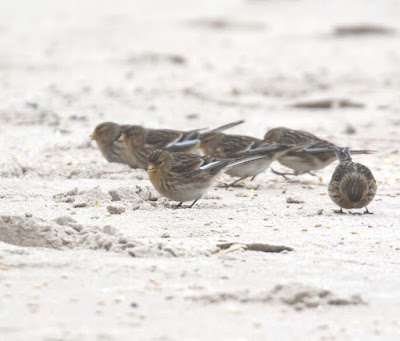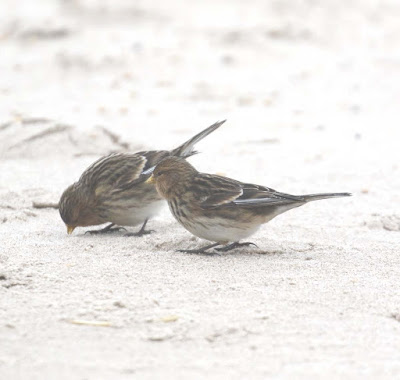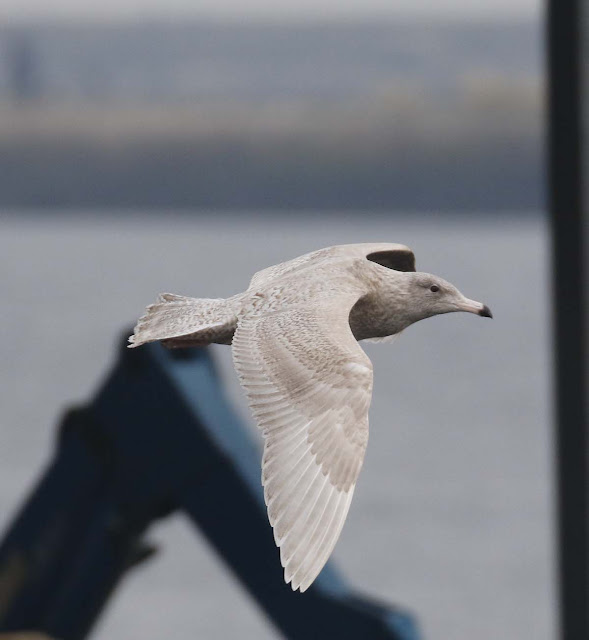I went to see the first ever Pacific Diver in Britain when one arrived on a small lake in South Yorkshire back in January 2007, so you can understand my interest when another one was found on Sunday, frequenting Ladyburn Lake which is part of the Druridge Bay Country Park in Northumberland
However, I had already planned to go to Newhaven in East Sussex to see a male Serin that has been spending the winter there. In bed on Saturday night my mind veered wildly between the two options with first one and then the other being preferred but I finally settled on Newhaven as it was only a two hour drive as opposed to a five hour odyssey to Northumberland, and if I went to Newhaven there was no need to get up extra early.
Currently, I am suffering a bit with a bad shoulder which, whilst not troubling me during the day when I am upright becomes painful at night after I have been asleep and prone for a few hours. So much so that the pain is usually bad enough to waken me in the middle of the night and it is impossible to get back to sleep.
Thus, in the early hours of Sunday morning I found myself awake and staring at the bedroom wall and in some discomfort. Dazed and miserable I mulled over my birding options once more and in the end decided to go to Northumberland, as although it was a five hour drive, at least I would be doing something other than lying or sitting in bed, wide awake and in pain.
It was, as it always is in such situations, a huge gamble as I had no idea whether the diver would still be there but I had a back up plan if it wasn't, in that there was a Pine Bunting further south in North Yorkshire and if not that then a White billed Diver in Lincolnshire, both good birds to see.
Sitting up and driving, my shoulder gives me no pain, so I steadily drove my way northwards on very quiet roads and wondered just what exactly I had let myself in for. It is a very long way to Ladyburn Lake, longer than I had anticipated but the adventure was now on and there was no going back. Hours later I passed the huge rusted sculpture that is The Angel of the North at Gateshead and when I was passing Newcastle checked RBA(Rare Bird Alert). My luck was in, as there was a report on my phone's screen that the Pacific Diver was still present at Ladyburn Lake at seven thirty this very morning
Thirty minutes of driving north of Newcastle, I turned onto an empty rural road and after a few twists and turns found myself in a free car park by Ladyburn Lake at just after nine am. In complete contrast to the freezing and icy weather when I left home, here it was cold, damp but well above freezing, although needless to say there was no sign of any of the forecast sunshine. Already there were considerable numbers of people here, assembling to go on morning constitutionals, jogging in lycra or walking dogs but there was plenty of space around the large lake for everyone to lose themselves. I expected that quite a crowd of birders would have come to see the diver, as judging by the images I had seen on the internet yesterday, it was remarkably confiding and allowing close approach.
I looked around the lake and at first could see very few birders but closer inspection revealed scattered groups of birders stationed at the far end of the lake where gaps in a narrow border of dead reeds allowed an open view of the lake and I could see that the birders were obviously looking at the diver.
There could not have been more than thirty birders present this morning whereas the diver in Yorkshire had attracted hundreds. Admittedly the Yorkshire bird was the first for Britain but this individual on Ladyburn Lake was only the eighth record of this species in Britain so I would have thought it merited far more attention, especially as it was a weekend.
 |
| Ladyburn Lake and the reeds and water at the eastern end where the Pacific Diver was to be found |
 |
| Some of the birders that came to admire the Pacific Diver |
I met several birders coming towards me who obviously had already seen enough of the diver and they confirmed that it was extremely obliging and coming very close at times. So all was well and I made as much haste as I could to get nearer to the diver.
I got to the first small group of birders and could see the diver some way offshore and asleep. I was told not to worry as the diver would soon come closer when it started feeding. Five minutes later it woke up and commenced to preen, rolling over on its side in the water and exposing its silky white underparts and waving a large foot with lobed toes in the air as it spun in the water preening its belly feathers.
Once it had finished preening, it dived, commenced feeding and as predicted started coming closer and closer to the shore. Soon it was just a few metres from us and cameras went into overdrive recording superb views of a major rarity.
The diver seemed to have a preferred routine whereby it would feed just beyond the narrow band of dead reeds by the lake shore. Frustratingly, apart from the one earlier, memorable moment when it came very close, it kept to just beyond the reeds and often hidden out of sight behind them. I waited, hoping that sooner or later it would give me my opportunity to see it well as it came past one of the gaps in the reeds and with a little luck this would allow me to get a nice photo.
I was joined by a very nice gentleman with a huge lens and a very strange accent.We got talking whilst waiting for the diver to co-operate and I just could not place his accent until he told me he was from Germany but had been living in Newcastle for the last fifteen years and his accent was a combination of both places. We waited and talked as birders do. Another local and very friendly birder by the name of Sean joined us and we formed a harmonious trio all intent on seeing the diver well, just once more.
A skein of Pink Footed Geese flew over, the pig like squeals and chattering of the geese clearly audible, high in a dull grey sky that was thankfully fog free but still nowhere near realising the sunny day that had been predicted. A Kingfisher flashed past the gap in the reeds, showing such a strange missile like profile, their enormous head and long bill dwarfing their small body.
The diver still did not co-operate but tantalisingly either just briefly allowed a clear view of it behind the reeds or swam further out on the lake and then slept and preened. Finally it made another approach to the reeds and this time instead of remaining behind the reeds dived and fed in the open and allowed very close views of it for about ten minutes before it dived once more and surfaced back near the reeds.
My patience and that of many others who had waited had now been amply rewarded with brilliant views of the diver. It was a juvenile, now in its second calendar year as evidenced by the buff fringes to its upperparts giving it a scaly appearance.
Pacific Divers look very much like our Black throated Diver and are the North American equivalent but there are diagnostic differences if you apply careful scrutiny. The flanks of Pacific Divers are entirely black whereas there is usually a large bulging white spot visible at the rear of the Black throated Diver's flanks and the ear coverts are smudged grey whereas they are white on Black throated Divers. Structurally Pacific Divers are slightly smaller, with a finer, shorter bill, steeper forehead and more rounded head and fuller neck. There is also a thin strap like line across the upper throat although this can be absent on some juveniles. I could just about see the semblance of one on this particular bird but only just. There is also another bolder strap line across the vent which was clearly visible when this individual was roll preening.
 |
| You can clearly see the strap line across the vent in this image |
The diver went back to its now familiar routine behind the reeds and I realised that I had been watching the diver for ninety minutes which seemed to have gone in a flash. I chatted to Sean about other local places to go birding before heading South and he suggested East Chevington NWT as there was a flock of seven Shorelarks wintering there plus a good flock of Twite, and then if I had time I should go a little further south to North Shields to see the Glaucous Gulls at a place called Fish Quay. Both East Chevington and North Shields were within one hour's drive from Ladyburn Lake so this was ideal and would hopefully make the day an even greater success.
Sean said he would come with me and I could follow him to East Chevington in my car as it would be easier than him giving me complicated instructions. Not only that, he offered to drive me to my car which was in a more distant car park at Ladyburn Lake than his. What a nice gesture and one that made my day all the more pleasurable.You see, just a little kindness like this, unheralded and of no great consequence can have such a major positive impact on one's outlook for the rest of the day and beyond.
I duly followed Sean to East Chevington and it is just as well I did as I would certainly have got lost on my own. We turned off the main road and took a seriously potholed track for about a mile to where we parked, walked into the dunes and after about half a mile, onto a largely deserted beach.
 |
| East Chevington Beach |
 |
| Shorelarks |
They soon came fairly close and I could see their yellow bills and butterscotch coloured faces and breasts as they hopped along on the sand, forever active and busying themselves finding a seed which they would then manipulate by rapid movements of their mandibles until the husk was removed.
 |
| Twite |
 |
| Sanderling |
An hour or so passed happily in the company of Sean, both of us photographing and looking at the Twite but then it was time for me to bid farewell to the estimable Sean and be on my way to my last stop in the northeast, which was Fish Quay at North Shields. Here was the considerable incentive of possibly finding no less than two juvenile Glaucous Gulls. I will confess to having a bit of a thing about Glaucous Gulls, their size, unpredictable appearances in Britain and their sheer chutzpah all make them irresistible.
I survived a repeat of the pothole experience and regained the main road, then headed south for twenty minutes before turning off and into a depressing area of run down housing estates, all the while following the brown tourist signs for Fish Quay, which is located at the mouth of the mighty River Tyne and dates back to the 13th century. I was none too sure what to find at Fish Quay but for some reason had an image of a small, run down fishing area where trawlers came in from the North Sea.
Descending a steep hill down to Fish Quay I found my imaginings were far from the reality. Large blocks of expensive and tastefully built flats lined the steep sides either side of the road leading to Fish Quay, which itself turned out to be very much modernised and now had become a popular tourist attraction with many of the old buildings alongside the road converted into bistros, restaurants, brasseries and pubs. Further on, other old historic buildings had been refurbished, provided with plaques and returned to their former glory, and I should imagine the whole area is very popular in the summer months. Fish Quay although now re-generating into a thriving business community and tourist area is still a working fishing port as two long sheds either side of a small harbour on the northern side of the Tyne testify. The sheds represent what remains of the fishing industry with buoys, nets and machinery stacked neatly opposite each of the currently closed fish merchant stores and the few trawlers moored alongside the concrete walls.
 |
| The harbour area |
 |
| One of the shed roofs to be found either side of the harbour with gulls in situ |
 |
| Trawler moored by the concrete promenade |
 |
| Glaucous Gull-juvenile/ 2nd calendar year |
Two pairs of Eider Ducks swam into the dock and the males began their evocative cooing courtship calls as some more females and a first winter male joined them.The adult males are really beautiful, their plumage cold ice cream colours of white, green and pink offset by a black cap, flanks and tail.
 |
| Common Eider - a juvenile male and two females |
 |
| Common Eider-males |
 |
| Greater Black backed Gull-adult |
 |
| Greater Black backed Gull- juvenile/2nd calendar year |

This would do nicely and I joined the queue and duly purchased a cod and two portions of chips to take away in a handy box. I retraced the hundred metres or so to the harbour enclosed by the fishing sheds. I kept the cod for myself not having eaten since I left the house at 4am but flung some chips out onto the water. In an instant every gull on the shed roofs headed down to the water but they were beaten by a blizzard of Black headed Gulls. Smaller and more manouevrable they grabbed the chips before the larger gulls could but there were plenty more chips available. I scooped up some more chips, hurling them onto the water and this time one of the Glaucous Gulls threw itself into the gull frenzy that had ensued on the water below me .
It really was that easy. I now got more cunning and instead of throwing the chips onto the water threw them down onto the concrete before me. The result was just as I hoped. The Glaucous Gull flew and perched within a few feet of me, as bold as you like.
A long drive home awaited me but having experienced a day like this I knew I would be happy in body and soul
Who wouldn't be?













































No comments:
Post a Comment